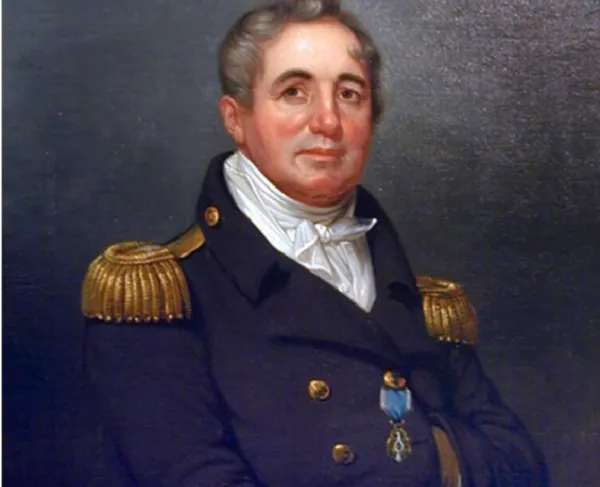Joshua Barney

Undaunted in Battle is a 2014 bas-relief sculpture, in the heroic mold of Saint-Gaudens’ Robert Gould Shaw and the 54th Massachusetts Infantry Memorial. Located in Bladensburg, Maryland the high relief depicts a crucial moment in the August 24, 1814 Battle of Bladensburg, where United States Navy Commodore, Joshua Barney, aided by an American sailor, and a freed black flotilla-man, Charles Ball, held off the last minute of the British assault. The wounded Barney, who sustained a musket ball lodged deep in his thigh, was captured by the British and paroled shortly after the battle. The site of the actual event, where 120 Marines and 360 sailors made a desperate last stand, is revered in Marine Corp lore. From this spot, the British moved on to capture and incinerate the public buildings of Washington, DC. It was a very low point in American military history.
Joshua Barney served in the United States Navy during the American Revolution and the War of 1812. During the American Revolution, he was captured three times, escaping after each capture. By the time America declared war on Great Britain in 1812, Barney was an accomplished and respected sea-faring veteran. As a child, he had been drawn to an adventure of life at sea and the water suited him just fine.
Born in Baltimore County, Maryland in 1759, he joined the American Navy at the age of 13 and three years later found himself in command of his own ship, in the Spanish Navy, fighting off the coast of Algiers in the Mediterranean.
After the American Revolution, Barney went into business as a successful merchant in Baltimore. When the War of 1812 erupted, he took command of the privateer, Rossie, which found much success plying in the waters off the coast of the new United States.
With a reputation in hand Barney, in 1813, approached the United States Secretary of the Navy William Jones requesting that he be given permission to create a special squadron, a small flotilla, to protect the vital waterways of the Chesapeake Bay. Jones approved the plan and Barney set to work building his sleek and fast-moving vessels. Each ship was a floating gun barge, capable of quick maneuvering, intended to harass, pester, and annoy British warships in the Chesapeake Bay. At the end of April 1814 Barney was given the rank as Captain in the U.S. Navy. In May 1814 the flotilla, now known as “Barney’s Flying Squadron,” headed down the Chesapeake to engage the British. Along the way they picked up the nickname the “Mosquito Fleet” given their fast pace and rapid maneuverability. Each ship’s crew consisted of veteran sailors including enslaved and free African-Americans.
For several months in 1814 the “Mosquito Fleet” attacked British warships before they were bottled up in the Patuxent River. With no way out, Barney ordered the fleet to be scuttled so it would not find its way into the hands of the British. Abandoning his ships Barney and his contingent of Marines and sailors marched overland to join the American defenses of Washington, D.C. They took up a good defensive position on a hill outside Bladensburg, but after four hours of intense hand-to-hand combat were overrun by superior numbers. Barney was captured but paroled for his courage by his captors, who respected the military élan of Barney and his men.
The bullet he received at Bladensburg had lodged so deep in his thigh that it was never able to be extracted and complications set in. He died in Pittsburgh, in 1818, bound for a new home in Kentucky.
Related Battles
200
250





